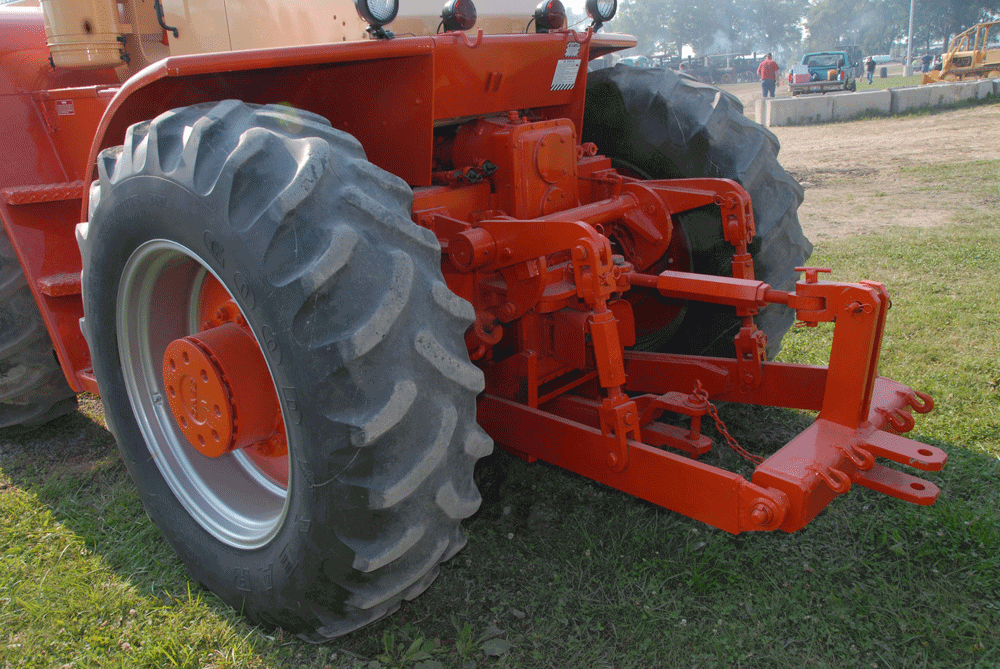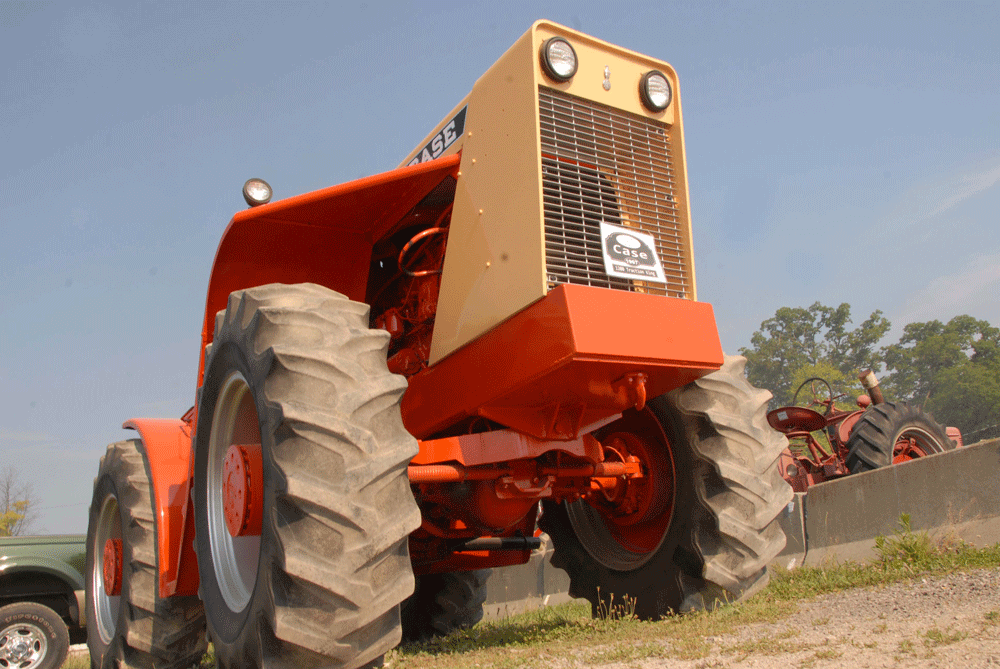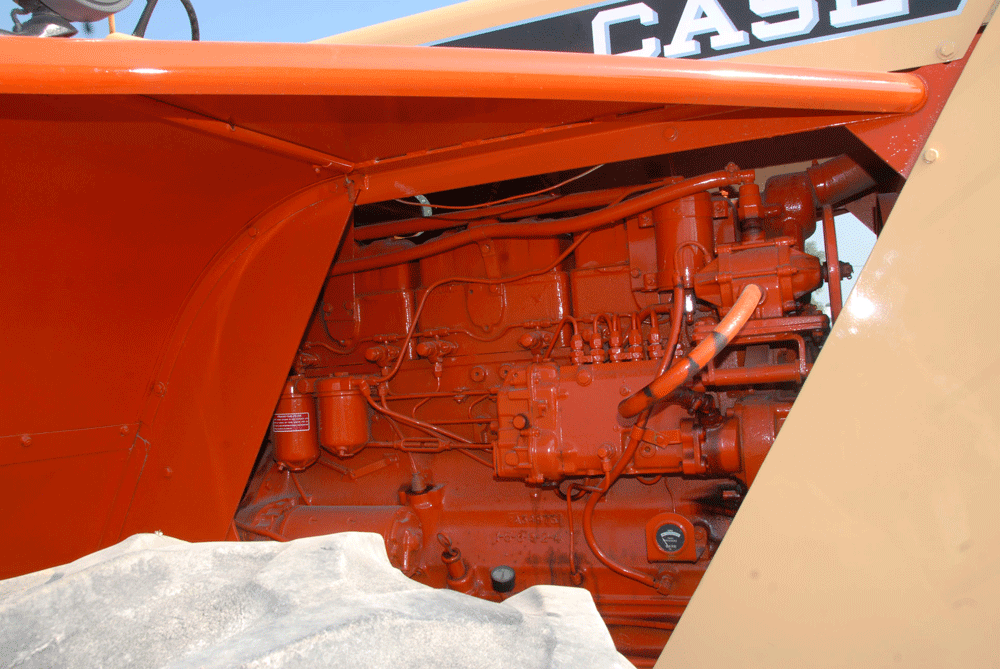Tractor Talk: 1967 Case 1200 Traction King
1967 Case 1200 Traction King
In the tractor horsepower race of the 1960s, all the manufacturers did their best conjuring to produce an affordable 100-plus horsepower tractor with no traction or weight issues. Two-wheel drive tractors required excessive weight to avoid high slippage over 100 hp but a large number of those were on the market. With so-so results, the market direction was clear and four wheel drive was the answer. Making it affordable required the “secret sauce.”
J.I. Case began stirring their saucepot in 1963 to produce their first four-wheel drive tractor; to meet the affordable criteria they worked under a number of self-imposed restrictions to keep costs down. The primary goal being: to use as many existing and off-the-shelf components as possible. While they could have gone really big, they realized it would be a while before really big matching implements were on the market so the team designed a smaller tractor with the side benefit of being more affordable.
The New 1200
The new tractor would use a rigid frame and four-wheel steering rather than a more expensive articulating chassis. It would have a commercially available six-speed transmission with an integral transfer case. The engine choice was a bit controversial within the company. Product planners opted for the company’s own 451ci six-cylinder Lanova cell diesel. It would produce a very modest 105 PTO horsepower. The marketing folks objected to this choice, saying it put them dead last in this new class of tractors right from the getgo. The engineering solution was to turbocharge the 451.
As we have discussed in the past, turbocharging a Lanova cell indirect-injected diesel is problematic. The Lanova Powrcel diesel injects across the combustion chamber into the Lanova chamber where combustion starts. Because the increased airflow of turbocharging tends to disrupt that process, the engine designers were required to compensate by redesigning the engine enough for it to work. When the smoke cleared, the 451 was rated for 120 PTO hp but the result was a fragile engine that tended towards excessive EGTs. They were spooked enough to included a pyrometer with a big decal warning about excessive EGT.
“They were spooked enough to included a pyrometer with a big decal warning about excessive EGT”


The original powertrain consisted of a pair of Eaton axles and a Clark 6-speed transmission. The tractor had a complex hydraulic system for the steering, which allowed for coordinated front and rear steering, front or rear steering only, or crab steering. This Case tractor is reputed to be the first tractor to offer this feature. It also had an optional rear 1000 rpm PTO and 3-point lift. The styling department didn’t have much input on the new tractor due to the rapid pace of development but they did get a little time for one mockup. The rapid development also left the tractor without a cab option, though an aftermarket unit was eventually available.
The first preproduction Case model 1200 Traction King tractors emerged early in March of 1964, not much more than a year after the program started. Full production started on March 23 and they went on sale shortly thereafter. It was marketed by Case as an “8-plow” tractor. That very subjective rating was common in the tractor world at that time but it put the 1200 in a great market position. It was a truly powerful tractor but in a size and price category (under $13,000) that was within the range of a medium-sized farming operation.
“Eaton axles and a Clark 6-speed transmission”


The 1200 became a market leader in many ways and, though the weak 451 Lanova held it back, 1,549 tractors were sold from mid-’64 through 1968. The engine problem was solved for 1968 with the introduction of the 1470 in January (see December 2015 Tractor Talk). The 1470 was essentially the same tractor as the 1200 with one major improvement, a 504 ci direct-injected, turbocharged engine that cranked out 145 PTO at 2000 rpm. The 1470 would evolve into the similar 1972 2470 which lasted until 1979 and that brought the hasty 1963 1200 design to it’s final answer. The 1200 was definitely a “hip shot” by Case. Any experienced action shooter knows without a lot of practice, experience and maybe a little luck, hip shots are off target more often than not. Case qualified in all three areas and their hip shot was right on target and produced a market leading tractor that both enhanced their business and set a market benchmark. DW

Typical Specifications:
1967 Case 1200 Traction King
Engine- Case 451T, IDI inline six
Displacement: 451ci
Bore & Stroke: 4.375 x 5 in.
*Rated PTO Power: 119.9 hp @ 2000 rpm
*Rated Drawbar Power: 106.2 hp @1998 rpm
Compression Ratio: 15:1
Transmission: 6-speed, Clark R500
Tires: 23.1-26
*Fuel Consumption: 8.2 GPH @ full power
*Drawbar Pull: 15,860 lbs. @ 12.1% slip
Weight: 16,585 lbs.
Fuel Capacity: 90 gal.
*Top Speed: 14.1 mph
*As Rated by Nebraska Tractor Test 868











